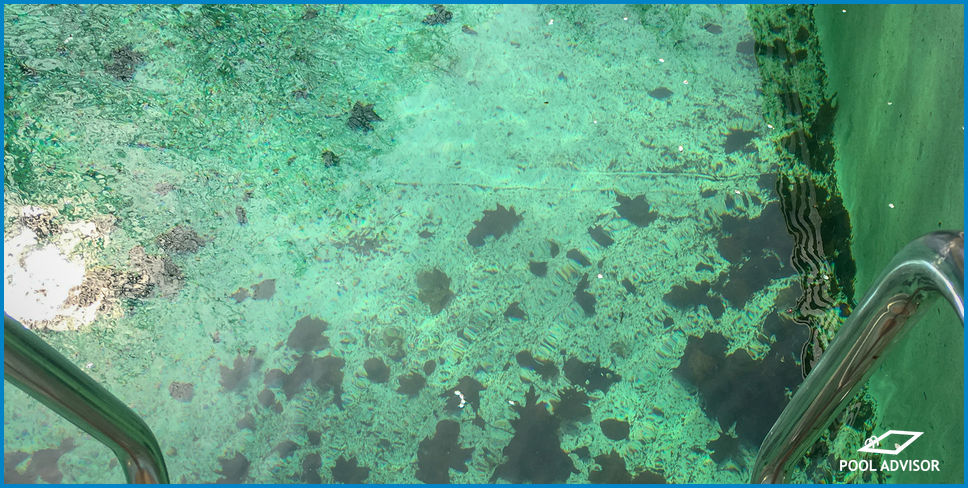
Black Algae In My Pool - Is It Dangerous?
Black algae is a persistent strain of algae that can be challenging to remove from pools, and it is also widely feared due to its relation to cyanotoxins. In this article, we will tell you how to identify black algae in your pool and discuss the potentially harmful effects of algae infestations.
How to Identify Black Algae
Black algae typically presents as a dark, blue-green colour that can often appear black when attached to pool surfaces.
Black algae causes raised spots where it has attached itself to your pool. It prefers to attach itself to rough surfaces, and does not scrub off easily. That said, it can appear in fibreglass pools just as easily as in pebblecrete pools.
Black algae spots usually have a texture that is similar to moss, but it can also feel slimy to the touch.
Is Black Algae Dangerous for Humans?
Much like green algae, black algae by itself is non-toxic and therefore is not harmful to humans unless it is ingested. However, black algae is known to release a substance known as cyanotoxins, which can have detrimental health effects.
Although many articles online discuss the harmful effects of cyanotoxins released by black algae, these effects can be prevented by tackling algae growth as soon as it appears. Minor algae infestations are unlikely to produce a significant number of these cyanotoxins, but the risk is increased when your pool is in poor condition.
In cases where your pool has been neglected, black algae can begin to pose a safety threat to humans. This is partially due to the increase in cyanotoxins, but also because algae can begin to harbour other types of bacteria that are harmful to humans, such as E. Coli.
Other factors can indicate that algae will grow to reach harmful levels, such as an accumulation of organic debris in the pool. In the next section, we’ll discuss the exact signs you can look for to determine if your pool is still safe to enter.
Should You Stop Swimming in a Pool With Black Algae?
Pools with a minor amount of black algae are usually safe to swim in as long as you are adequately maintaining your pool’s chemistry. However, if left untreated, black algae will continue to spread and will reach harmful quantities. Once you notice black algae forming, it is a good time to stop swimming in your pool and begin algae treatments.
We always recommend taking quick action when you notice any type of algae beginning to form in your pool. A fast response can lessen the amount of time and effort it takes to eradicate an algae infestation.
Black Algae and the Dangers of Cyanotoxins
If left untreated, a black algae infestation will produce enough cyanotoxins to affect your family. Certain factors can allow you to determine the severity of your algae problem.
First, consider the amount of surface area that your algae infestation covers. A mild infestation will only show a handful or two of small spots around your pool. An abundance of algae patches, -enough to cover a square metre or more when combined-, is likely a sign of a more serious infestation.
Other signs that your algae infestation has reached severe levels of toxicity include murky or cloudy water, a noticeable change in the smell of your pool, and difficulties maintaining normal water chemistry.
If your pool is showing one or more of these signs, it is crucial to avoid entering the water until your algae infestation has been resolved.
Cyanotoxins are known to be harmful to humans when ingested. Because this can include swallowing pool water or getting water up your nose, these instances tend to be more common among children. Most people who have ingested cyanotoxins show symptoms of gastrointestinal distress.
Cyanotoxins can also be absorbed through the skin, although this has not yet been well-studied. People with certain skin conditions may show greater signs of irritation when exposed to pool water containing black algae. This can include conditions such as eczema or psoriasis.
Conclusion
Black algae in small amounts can be harmless at first, but action should be taken immediately to avoid the risk of developing toxic pool water. Black algae when left untreated will release a dangerous amount of cyanotoxins and can harbour other harmful bacteria.
If you are looking to treat black algae, consider using a black spot remover.
Do you have any other questions about the dangers of black algae? We’d love to hear from you in the comments!

Louis
A chemical engineer by trade, Louis is committed to debunking myths in the pool industry by explaining the underlying chemistry and making it accessible to all.
